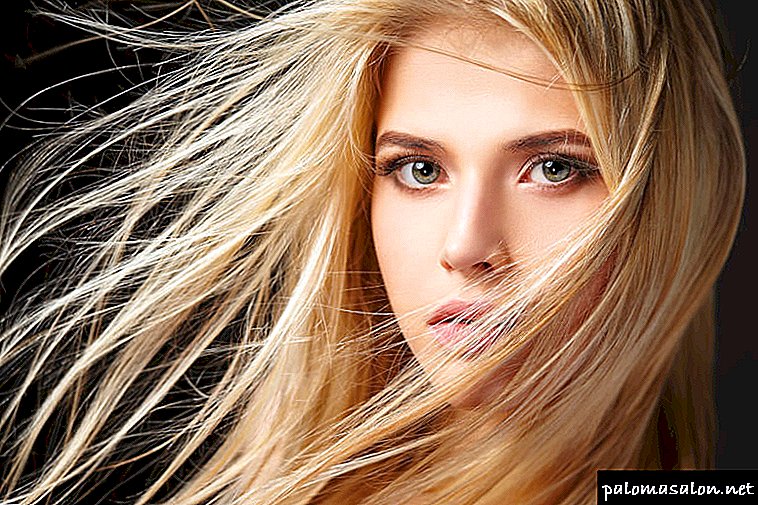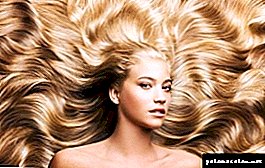
Numbers on the package will tell all about the shade of paint, you just need to figure it out. What do they mean? In this article I will talk about the universal numbering of hair dye shades, and explain what each of the numbers means.
The whole range of colors consists of 8 main rows:
0 - natural tones (green pigment)
1 - ash series (blue-purple pigment)
2 - matte row (green pigment)
3 - golden row (yellow-orange pigment)
4 - red row (copper pigment)
5 - mahogany series (red-purple pigment)
6 - violet row (blue-violet pigment)
7 - Havana (red-brown pigment, natural base)
The paint number usually consists of 3 digits.
The first is the depth of tone (from 1 to 10)
The second - the main shade
The third - an additional shade (it is usually 50% of the main)
Natural color range usually consists of 10 primary colors:
1.0 black color
2.0 very dark brown
3.0 dark brown
4.0 brown
5.0 light brown
6.0 dark brown
7.0 blond
8.0 light blonde
9.0 very light blond
10.0 pastel blond
In the above example, the color number consists of two numbers, which means that there are no additional colors in these colors. When choosing paint, you need to be guided by your color type and on this basis choose the depth of tone. For example, if your tone is 7, then it is advisable that you choose a paint with the first digit of 7. Otherwise, the resulting tone may be too dark or light.
To make it more understandable, we will analyze a specific example. Take a very common paint color, which manufacturers call "mocha". Usually his number is 5.75. The first number indicates that the base color 5 is light brown. The main shade is 7, that is, it belongs to the havana series and contains a red-brown pigment. Additional shade 5 - indicates the presence of red-purple pigment (mahogany number).
There is also a very convenient table, according to which it will be very easy to determine the color that will be obtained when mixing basic shades.
Hair structure

Human hair consists of a root - the living part, which is under the skin, and the trunk - the outer part, consisting of dead cells. The structure of the trunk, in turn, is represented by the following levels:
- 1. The inner layer consisting of keratin cells.
- 2. Cortical layer of elongated cells, including the melanin pigment.
- 3. The outer layer is the cuticle.
It is the melanin pigment that is responsible for the natural hair color. Natural is the so-called pure color, without any additional shades. The more this pigment is contained in a person’s hair, the brighter it is.
What do the numbers in the paint number
Most tones are indicated by one, two or three numbers. So, let's try to figure out what lies behind each of them.
The first digit indicates the natural color and is responsible for the level of its depth.. There is an international scale of natural tones: the number 1 corresponds to black, 2 to dark dark chestnut, 3 to dark chestnut, 4 to chestnut, 5 to light chestnut, 6 to dark blonde, 7 to dark blonde, 8 to light blonde , 9 - very light-blond, 10 - light-light-blond (or light blond).
Some companies add another 11 and 12 tones, denoting super-brightening paints.
If the tone is called only one digit, it means that the color is natural, without other shades. But in the designation of most tones there are second and third digits that decode shades of color.
The second digit - the main shade:
- 0 - a series of natural tones
- 1 - presence of blue-violet pigment (ashen series)
- 2 - the presence of green pigment (matte row)
- 3 - the presence of yellow-orange pigment (gold row)
- 4 - presence of copper pigment (red row)
- 5 - the presence of red-purple pigment (mahogany number)
- 6 - presence of blue-violet pigment (violet row)
- 7 - presence of red-brown pigment, natural base (havana)
It should be borne in mind that the first and second shades are cold, the rest are warm.
The third digit (if there is one) means an additional shade, which is two times less in color than the main one (in some colors, their ratio is 70% to 30%).
For some manufacturers (for example, Pallet paint) the color direction is indicated with a letter, and the depth of tone with a digit. The meanings of the letters are as follows:
- C - ashen color
- PL - platinum
- A - intensive clarification
- N - natural
- E - beige
- M - matte
- W - brown
- R - red
- G - golden
- K - copper
- I - intense
- F, V - purple
Decoding shades of colors (examples)
Consider the numerical designations of colors on specific examples.
Example 1 Hue 8.13 light brown beige paint L'oreal Excellence.

The first digit means that the paint belongs to the light-brown scale, but the presence of two more digits means that the color contains additional shades, namely, ashen, which is indicated by figure 1, and a little (twice less than that of ashes) golden (figure 3). ) which will add warmth to the color.
Example 2 Hue 10.02 light-light-blond tender from the L'Oreal Excellence palette 10.
 The number 10 to the point indicates the level of the depth of tone of the blond blond. Zero contained in the name of the color indicates the presence of natural pigment in it. And finally, the number 2 is a matte (green) pigment. In the following digital combination, we can say that the color will be rather cold, without yellow or red hues.
The number 10 to the point indicates the level of the depth of tone of the blond blond. Zero contained in the name of the color indicates the presence of natural pigment in it. And finally, the number 2 is a matte (green) pigment. In the following digital combination, we can say that the color will be rather cold, without yellow or red hues.
A zero in front of another digit always means that there is a natural pigment in the color. The more zeros, the more natural. Zero, located after the number, says about the brightness and saturation of the hue (for example, 2.0 deep black L'oreal Excellence 10).
You should also be aware that the presence of two identical numbers indicates the concentration of this pigment. For example, two sixes in the name of the shade 10.66 polar from the Estel Love Nuance palette indicate the color saturation with the purple pigment.
Example 3 Hue WN3 golden coffee cream paint Palette.
 In this case, the color direction is shown with letters. W is brown, N denotes its naturalness (similar to zero, located in front of another digit). The next number is 3, indicating the presence of a golden pigment. Thus, it will turn out quite natural, warm brown color.
In this case, the color direction is shown with letters. W is brown, N denotes its naturalness (similar to zero, located in front of another digit). The next number is 3, indicating the presence of a golden pigment. Thus, it will turn out quite natural, warm brown color.
Every woman who prefers coloring at home to salon coloring should be guided by the symbols used by hair dye manufacturers. This will help you choose the right shade and avoid annoying disappointments.
Tone level
First, in the scale of natural shades, you choose a color that matches your natural hair color. Then see which digit it corresponds to - this is your tone level.
Choosing the desired color in the table, you must determine:
- first, what level of tone does it correspond to,
- secondly, the tone level of the hair that is going to dye,
- thirdly, calculate the difference between them.
It is necessary for the selection of the dye and the brightening component.
This graph shows which shade is added to the base color. Each shade has a gradation depending on the tone of the hair.
In the table of colors for coloring hair, only the main shades are highlighted, between them, depending on the concentration of adjacent colors, you can get a large number of shades.
Mixestons (from the English .mix - mix and Greek. Tonos - tone, hue of color) are used to enhance a particular color direction, as well as color correction.
As independent paints they are not applied. With the help of the mixton, the shade is given brightness and saturation. This paint enhances natural shades.
Preliminarily lighten hair, you can dye your hair with a mixton in unusual, non-traditional colors.
Mixestone Palette
Ashy, gray, blue - strengthen the ashy hair color, at the same time giving it a matte shade.
Golden (in its concentration corresponds to golden-orange) can be mixed with all shades:
- gray tint gives a silvery shade.
Golden red corresponds to a red-orange shade. It makes red tones warmer, and golden gives a reddish tint.
Red (corresponds to the red tone) - enhances the brightness of the color and gives a warm shade. It can be added to all tones, except ashen.
Violet (contrasted with yellow) - used to destroy yellowness. In large quantities enhances the effect of purple.
Green (contrasted with red) - eliminates unwanted red, while not making the color darker.
Bright, light - does not contain pigment. Lighten their hair can not. It is used to change the hue towards a light tone. With basic tones is not used.
Scheme № 1. Complementary combination
Complementary, or complementary, contrasting colors are those that are located on opposite sides of the Itten color wheel. Their combination looks very lively and vigorous, especially with maximum color saturation.

Scheme number 2. Triad - a combination of 3 colors
The combination of 3 colors lying at the same distance from each other. Provides high contrast while maintaining harmony. This composition looks quite lively even when using pale and unsaturated colors.

Scheme number 3. A similar combination
The combination of 2 to 5 colors, located next to each other on the color wheel (ideally - 2-3 colors). Impression: calm, comfortable. An example of a combination of similar muted colors: yellow-orange, yellow, yellow-green, green, blue-green.

Scheme No. 4. Separate-complementary combination
A variant of a complementary color combination, but instead of the opposite color, adjacent colors are used. The combination of the main color and two additional. This scheme looks almost as contrasting, but not so intense. If you are not sure that you can properly use complementary combinations, use separate complementary ones.

What are the colors
Before changing your image, you should carefully study this market segment and choose the most appropriate means. Depending on the incoming components and durability, the materials for painting can be divided into:
- chemical dyes
- physical dyes,
- natural dyes.
Chemical paints
At the moment, such compositions are indispensable. Despite the fact that they can adversely affect the condition of the hair, provide rich color and durability.
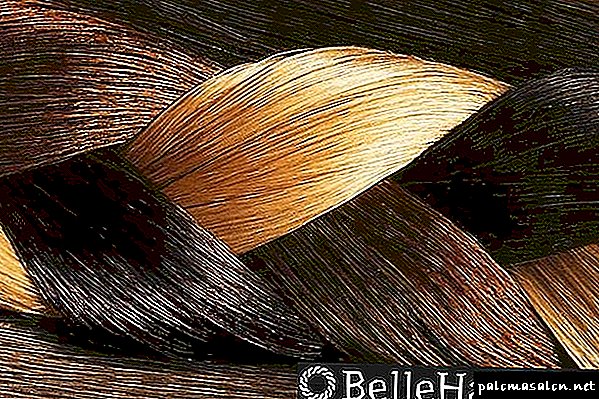 You can smooth out the negative impact of such a dye using special cosmetics for damaged hair that has been dyed.
You can smooth out the negative impact of such a dye using special cosmetics for damaged hair that has been dyed.
The main problem is dryness, which cannot be solved with proper care and time costs.
The compositions of this group are divided into two types:
- Persistent. They contain hydrogen peroxide in their composition, they are able to penetrate deeply into the hair structure. Most often produced in the form of cream-inks, which provide a long and steady color. Staining occurs on the basis of an oxidative reaction.
- Without ammonia. More gentle option, but the resistance is much lower. Such paints are now in great demand, as modern women think about changing their image without harm to hair and are ready to frequently update the color.
Physical paints
 Use of physical hair dye
Use of physical hair dye
This category includes compounds that can not penetrate deep into the hair and hold for a short time.
The advantages include:
- no ammonia and hydrogen peroxide,
- the possibility of frequent use without harm to the hair,
- convenient form of release, suitable for use in the home.
It is best to choose such dyes if the purpose of the procedure is to desire to slightly change the natural color or give the hair an attractive appearance due to a brighter shade. In addition to coloring, the formulations take care of the hair and do not require special skills and preparation for use. Manufacturers manufacture their products in the following forms:
Natural paints
 Such compositions do not damage the curls, on the contrary, care for them
Such compositions do not damage the curls, on the contrary, care for them
Allow without serious expenses and efforts to emphasize the natural color. The disadvantages include:
- do not penetrate the hair structure because of what is short-lived,
- limited color gamut.
Types of coloring compositions have been known for a long time. You can dye your hair what is sold in the nearest store or is available on the farm. For the procedure apply:
 Natural Iranian henna for hair
Natural Iranian henna for hair
 Onion Husk for hair coloring
Onion Husk for hair coloring
The effect of such compositions can not be compared with chemical paints, but for the care and small changes they can be used.
How to choose a professional hair dye: Estelle, L'Oreal, Garnier
First you need to define a task. A woman should understand what she expects from change. If the plans are a long-term change in appearance and there is confidence that the chosen shade is suitable, you should choose chemical dyes. For color matching and experiments, they stop on physical formulations that will not damage the hair and leave room for retreat.
 The process of dyeing hair with physical paint
The process of dyeing hair with physical paint
When choosing a chemical dye is recommended to consider the following tips to preserve the beauty of curls:
- the content of hydrogen peroxide is in the range of 6-9%, the smaller it is, the more sparing composition,
- preference is given to products without ammonia in the composition,
- it is desirable to make a choice in favor of those paints that contain caring components (vegetable oils, proteins, vitamins of group B, E and A, filters for UV protection),
- You should not buy a composition that includes salts of zinc, lead, manganese,
- paints with an expired shelf life give an unpredictable result, so their use should be abandoned.
 Expired inks give unpredictable results.
Expired inks give unpredictable results.
Tip! The final color is influenced by a large number of factors. The main ones are the original shade of hair. In addition, if the hair is already colored (especially with natural dyes, such as basma and henna), it is recommended to refuse self-coloring. The result in this case is unpredictable.
Color type and hair color
In nature, everything is harmonious, so the original color of hair, eyes and skin are in harmony with each other. Bad shade one that does not match the type of appearance. Conventionally, there are four seasons.
 Determine your type is not difficult if you know the main features.
Determine your type is not difficult if you know the main features.
Most often, ladies who pay attention to their appearance know this as twice two. Regarding hair, you can make the following recommendations:
- Spring. Worth saying no to cool hues. Preference is given to chestnut, light brown, wheat, straw, light and ginger colors with a warm sheen.
- Summer. The most common type in the country. Red and red shades will not work. All variants of light brown, brown-haired, silver ebb will become a successful solution.
- Autumn. The color of this season is red. Without fear, you can choose copper, chestnut and shades of warm chocolate. Cold colors will not work, so you should give up on platinum, as well as wheat and red, close to orange.
- Winter. here you can afford bright and extravagant experiments. Colors such as pink, red, eggplant, blue and burgundy will look great. From the classic you can stay on black. You should not choose platinum, straw, light-brown colors and shades with a green sheen.
How to determine the paint color on the palette (table) shades: 1,5,6,7,8
To avoid confusion developed a universal designation of colors. Do not blindly believe the label on which the color description is written.
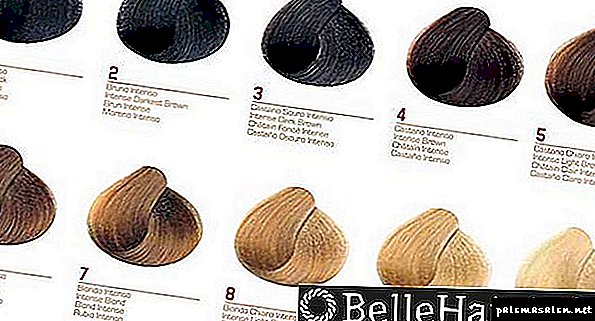 International Color Scale Hair Dye
International Color Scale Hair Dye
The value of hair dye numbers will help to choose more precisely.
Deciphering the number of the main color of hair dye
The first stage allows you to determine the primary color. The hair tone table includes 12 items. If there is no desire for a cardinal change of image, then you should choose the figure that corresponds to the natural color.
- 0 - natural,
- 1 - black tone,
- 2 - chestnut (very dark),
- 3 - chestnut (dark),
- 4 - chestnut,
- 5 - light chestnut color,
- hair color 6 - dark blonde,
- hair tone 7 is light brown,
- 8 - light brown (light),
- 9 - blond,
- 10 - blond (light),
- 11 - blond (very light),
- 12 blond (platinum).
Shade determination by number
Further decoding hair dye includes shade. The marking is separated from the first value by a dot or a slash. There are 9 options, in one designation two can be included at the same time (this means that the paint combines two shades). The hair color chart looks like this:
- 0 - natural,
- 1 - ashen (blue),
- 2 - ashen (lilac),
- 3 - gold
- 4 - red copper,
- 5 - red (purple),
- 6 - red,
- 7 - Khaki,
- 8 - ashen (pearl),
- 9 - ashen (cold).
Marking paint may have the following form: 6.9 or 6/46. Sometimes you can find the letter numbering, which is slightly different, but also includes 9 options.
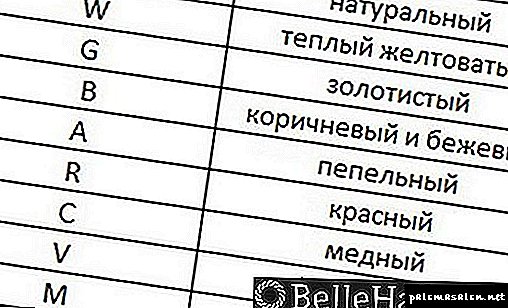 Two letters are used for designation.
Two letters are used for designation.
Choosing the right hair color is not as difficult as it seems!
Restore the original colors of the picture
Information about the original colors of the picture is saved with it, so you can restore them at any time.
Click the picture, open the tab. Format and click Reset drawing parameters.
Change pattern in grayscale or black and white
Select the pattern you want to change.
Tab Format press the button Repaint and select item Grayscale.
Restore the original colors of the picture
Information about the original colors of the picture is saved with it, so you can restore them at any time.
Click the picture, open the tab. Format and click Reset drawing parameters.
You can reduce the number of colors in a pattern in one of three ways:
Change the pattern in shades of the same color.
Change pattern in shades of gray.
Change the picture in black and white.
Note: You can change images that are stored in Encapsulated PostScript (EPS) format only in shades of gray or in black and white.
What do the numbers in the numbers of hair dye mean - useful tables of numbers shades of colors
In the choice of paint, each woman is guided by her own criteria. For one, brand awareness becomes the decisive factor; for the other, the price criterion; for the third, originality and attractiveness of the package or the presence of a balm in the kit.
But as for the choice of the shade itself - in this all are guided by the photo placed on the package. In extreme cases, the name.
And rarely will anyone pay attention to the small numbers that are printed next to the beautiful (like “chocolate smoothie”) shade name. Although it is these numbers that give us a complete picture of the shade presented.
So, what you did not know about and what should be remembered ...

What do the numbers on the box say?
On the main part of the shades represented by different brands, tones are indicated by 2-3 figures. For example, "5.00 Dark Blonde."
- Under the 1st digit implies the depth of the primary color (approx. - usually from 1 to 10).
- Under the 2nd digit - the basic color tone (note - the figure comes after a point or fraction).
- Under the 3rd digit - additional shade (approx. - 30-50% of the main shade).
When marking with only one or 2 digits it is assumed that there are no shades in the composition, and the tone is exceptionally clear.
Decipher the depth of the main color:
- 1 - refers to the black color.
- 2 - to dark dark chestnut.
- 3 - to dark chestnut.
- 4 - to chestnut.
- 5 - to light chestnut.
- 6 - to dark blond.
- 7 - to the light brown.
- 8 - to light-blond.
- 9 - to a very light brown.
- 10 - to light-light-blond (that is, light blond).
Individual manufacturers may also add 11th or 12th tone - This is a super-brightening hair dye.
Next - decipher the figure of the main shade:
- Numbered 0 A number of natural tones are assumed.
- Numbered 1 : there is a blue-violet pigment (approx. - ash row).
- Under the number 2 : there is a green pigment (approx. - matte row).
- Under the number 3 : there is a yellow-orange pigment (approx. - a gold row).
- Under the number 4 : there is a copper pigment (approx. - red row).
- Under the number 5 : there is a red-violet pigment (a comment - a mahogany row).
- Under the number 6 : there is a blue-violet pigment (a comment - a violet row).
- Under the number 7 : there is a red-brown pigment (approx. - natural base).
Should remember that 1st and 2nd shades refer to cold, others - to warm.
We decipher the 3rd digit on the box - an additional shade
If this number is present, it means that your paint has extra shade, the amount of which relative to the base color is 1 to 2 (sometimes there are other proportions).
- Numbered 1 - ashy tint.
- Under the number 2 - purple hue.
- Under the number 3 - gold.
- Under the number 4 - copper.
- Under the number 5 - mahogany shade.
- Under the number 6 - red tint.
- Under the number 7 - coffee.
Individual manufacturers designate color by letters, not numbers (in particular, Pallet).
They are deciphered as follows:
- Under the letter C you will find ashen color.
- Under PL - platinum.
- Under a - super lightning.
- Under N - natural color.
- Under E - beige.
- Under M - matte.
- Under w - Brown color.
- Under r - red.
- Under g - gold.
- Under K - copper.
- Under i - intense color.
- And under F, V - Violet.
It has a gradation and paint resistance. It is also usually indicated on the box (only in another place).
- Under the number "0" paints with a low level of resistance are encrypted - paint “for a while” with a short effect. That is, tinted shampoos and mousses, sprays, etc.
- The number "1" speaks about the color product without ammonia and peroxide in the composition. Such means refresh dyed hair and add shine.
- The number "2" will talk about the paint's semi-resistance, as well as the presence of peroxide and, sometimes, ammonia. Resistance - up to 3 months.
- The number "3" - these are the most resistant paints that drastically change the main color.

On a note:
- “0” before the digit (for example, "2.02"): the presence of natural or warm pigment.
- The more "0" (for example, "2.005"), the more natural in the shade.
- "0" after the number (for example, "2.30"): saturation and brightness of color.
- Two identical numbers after point (for example, "5.22"): pigment concentration. That is, the enhancement of additional color.
- The more "0" after the point the better the shade will block the gray hair.

Examples of decryption palette of hair colors - how to choose your number?
To assimilate the information obtained above, we will analyze them with specific examples.
- Hue "8.13" , presented as light-blonde beige (paint "L'oreal Excellence"). The number “8” indicates a light-brown scale, the number “1” indicates the presence of an ashen shade, the number 3 indicates the presence of a golden color (it is 2 times less than the ashy).
- Hue "10.02" presented as a light blond light tender. The number “10” indicates such a depth of tone as “light blond”, the number “0” indicates the presence of a natural pigment, and the number “2” is a matte pigment. That is, the color in the end will be very cold, and without the red / yellow shades.
- Hue "10.66" called Polar (Estel Love Nuance palette). The number “10” indicates a light-light-brown scale, and two “sixes” indicate the concentration of the violet pigment. That is, the blond will turn out with a purple tint.
- Hue "WN3" , referred to as "golden coffee" (approx. - Palette cream paint). In this case, the letter “W” indicates a brown color, with the letter “N” the manufacturer designated its naturalness (approx. - analogously to zero after a dot with the usual digital encoding), and the number “3” indicates the presence of a golden hue. That is, the color will eventually be warm - natural brown.
- Shade "6.03" or Dark Blonde . The number “6” shows us a “dark-light” base, “0” indicates the naturalness of the future shade, and the number “3” the manufacturer adds a warm golden nuance.
- Tint "1.0" or "Black" . This option without auxiliary nuances - there are no additional shades. A “0” indicates exceptional natural color. That is, in the end, the color is pure deep black.
Of course, in addition to the symbols in the numbers indicated on the original packaging, you should also take into account the peculiarities of your hair. Be sure to take into account the fact of pre-coloring, highlighting or just lightening.

